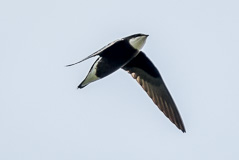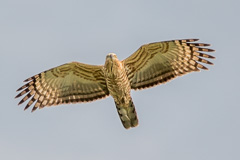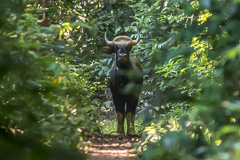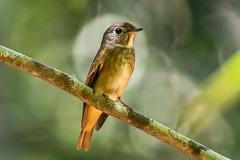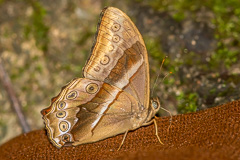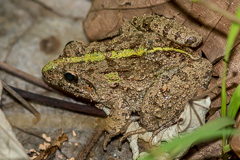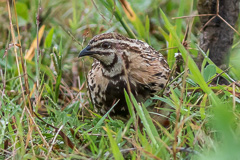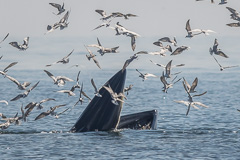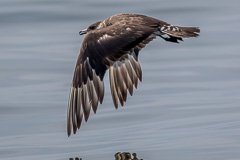Overview
Dates: |
24 Oct - 10 Nov 2015 |
With Ian Dugdale and, in part, Games Punjapa Phetsri. With a couple of weeks pencilled in for exploration of sites new and old we deliberately left our itinerary totally open, making decisions based solely on weather, target species, recent bird sightings plus whatever took our fancy. As usual we started with the annual pilgrimage to Khao Dinsor for the raptor migration.
23 Oct. A long drive south from Chiang Mai as far as Hua Hin to overnight. Other than two lunatics driving at speed the wrong way in the fast lane of the highway north of Tak an uneventful journey A few showers en route.
24 Oct. Arrived midday at Thung Wua Lean where met up with Ian and Games. Lunch on the beach, after which we ascended Khao Dinsor to join the throng of photographers at the first viewing platform. Luck certainly on our side, as within ten minutes a Short toed Snake Eagle drifted over - quite amazing given that this was our number one target with only a few individuals recorded in any year. Weather hot and sunny with much haze from Indonesian fires. A variable procession of species during the afternoon with Booted Eagle, over 1,000 Black Baza, Oriental Pratincole, Western Osprey, White-bellied Sea Eagle, Ashy Minivet, a single White-throated Needletail and another Thai rarity late afternoon, in the form of a Eurasian Hobby. 25 Oct. With Games tied up with clients on tour, it was left to the two of us to start at Khao Dinsor this morning. No sooner had we started to ascend than an unexpected shower hit, causing us to pause at the first shelter for half an hour. Much windier today with a strong onshore breeze resulting in much improved visibility. Spent all morning at the lower platform before moving to the upper platform mid afternoon. Another good day with Western Osprey, 3 Jerdon's Baza, 3,000 Black Baza, 5 Booted Eagle, 30 Shikra, 6 Chinese Sparrowhawk, 400 Japanese Sparrowhawk, 3 Eastern Marsh Harrier, 3 White-bellied Sea Eagle, 1,000 Grey-faced Buzzard, 130 Oriental Pratincole, 6 White-throated Needletail, 20 Pacific Swift, another Eurasian Hobby, a couple of Peregrine Falcon and 200 Ashy Minivet. |
26 Oct. Fairly cool and overcast so quite refreshing on the mountain. Despite being a Monday the number of photographers at the lower platform had swelled to more than comfortable so movement around the platform rather restricted. A good movement of Black Baza today with a couple of Jerdon's Baza the highlight. Windy but cloudy till about 11:00 with rain starting at 11:30. After an hour of sitting waiting for it to cease we gave up and descended back to our accommodation to partake of something more useful. Late afternoon, although cloudy and damp, at least the rain had stopped, so we headed to Kapo Waterfall for some evening birding and herping - finding a couple of small interesting frogs, we struggled to identify. Few birds in the damp conditions, but Taiga Flycatcher worthy of note and Collared Scops Owl and Asian Barred Owlet calling after dusk.
27 Oct. Heavy overnight rain with cloud and showers early morning forced us to reconsider our options. With little point in attempting Khao Dinsor we spent the morning lounging around at the accommodation. With improving afternoon weather - well at least not raining - we headed up the hill again, with many the same species as yesterday plus a Pied Harrier. Heavy rain and fierce wind early evening meant a power cut for a couple of hours at Thung Wua Laen.
28 Oct. After Khao Dinsor our initial thoughts had been to head to parts southward, but a look at the weather prediction for the next week suggested we'd better head northward. Before leaving we had a final session on Khao Dinsor, with excellent weather and us adding Common Kestrel and Common/Japanese Buzzard to the trip list. Left Khao Dinsor at 12:00 in an attempt to twitch Little Stint - a Thai rarity - that had been observed at Laem Phak Bia yesterday. We managed an hour here but couldn't convince ourselves of any odd looking stints, so opted to overnight in Phetchaburi. 29 Oct. Back to Laem Phak Bia just after dawn to again peruse through the stints on offer. Very difficult to obtain any close views, so after an hour we quit and headed to Khok Kham where they had also been reported earlier. Much more promising here, with one particular pool full of stints allowing close approach by vehicle. After 40 minutes of scanning we discovered a prime candidate Little Stint, with good views obtained. Flushed with success, we drove to Khao Ang Rue Nai where in the last couple of hours of light we birded the waterfall track before the checkpoint, resulting in a couple of Green Imperial Pigeon and a treeful of Thick-billed Green Pigeon. Overnight at small resort locally. 30 Oct. As ever, in pursuit of the mythical Asian Woolly-necked Stork, we returned to Khao Ang Rue Nai as far as first ranger station cum checkpoint where we were informed that the track to the waterfall was basically blocked. Managed to convince the rangers we would drive and then walk, so were able to continue a further three kilometres at which point a number of tree falls blocked our route. Spent the next six hours walking a further four kilometres and back in the vain hope of finding Asian Woolly-necked Stork, but as usual, no chance. A good morning with Green-legged Partridge, Siamese Fireback, Malayan Night Heron, Orange-breasted Trogon, Oriental Dollarbird, Red-breasted Parakeet, Banded Broadbill, Blue-winged Pitta, Ferruginous Flycatcher, Van Hasselt's Sunbird and Crimson Sunbird. Also a young male Gaur in the track which fortunately decided to leave rather than investigate us. Plenty of leeches. We then headed southeast toward Chanthaburi where we stayed overnight east of town. |
31 Oct. Now having arrived in the southeast again, this was our forth attempt to find the four Thai specialities of the area. These four species - Blue-rumped Pitta, Chestnut-headed Partridge, Black-browed Fulvetta and Indochinese Green Magpie remain elusive to Thai birders due to a mixture of remote location, difficult access, lack of trails to any decent altitude, few sightings since historical times and poorly known distributions. Our past three trips in 2011, 2013 and 2014 had resulted only in a single sighting of Chestnut-headed Partridge. Having previously tackled Khao Soi Dao and Khao Khitchakut, we initially turned our attention to Namtok Phlio National Park from which there are historical records of the fulvetta and magpie.
Until recently renamed as Namtok Phlio, this park was formerly known as Khao Sabap National Park, and the massif hosts several waterfalls at intervals around its perimeter, the largest of which is Phlio Waterfall. We arrived at the main entrance just on 07:00 - well before the general public to this busy waterfall. A short walk to the stupa and then onto the Nature Trail loop of 1.2 kilometres. Although the habitat looked good, birds were few and far between, with the altitude barely touching 100 metres. An hour's walk up a dry mountain stream enabled us to get to about 150 metres only, so clearly something different was required. In the afternoon we investigated Makok Waterfall on the eastern side of the park, where a 600 metre trail went likewise to only 145 metres, and mainly through secondary growth. We then headed to Trok Nong Waterfall, also on the east side. Here we discovered an old unkept Nature Trail which took off straight up the hill, rapidly climbing to 200 metres, but then descending again to a stream where the trail disappeared and could not be followed. So typical of Thai parks - build trails and let them fall into disuse. A tough day, on poor trails with a poor bird list to boot of only thirty species. Found a small resort nearby to look more thoroughly at Google Earth and try to come up with a plan for the next few days. |
1 Nov. Back to Trok Nong waterfall, and a second attempt at the Nature Trail. With the assistance of GPS we managed to refind the old sections of trail, eventually fighting our way through bamboo and rattans to a higher waterfall at 270 metres, that was clearly the intention of the trail before falling into disuse. Better bird activity early on with three Malayan Night Heron flushed in the forest. Retraced our steps, finding a shortcut back to the main river through the park. A hot, hard day with still no sign of any specialities.
2 Nov. We returned to Phlio Waterfall on the west side of the park for another attempt to walk higher up the dry mountain river we'd encountered two days previously, with another Malayan Night Heron flushed en route. Overnight rain made the going slow due to the boulders in the river bed now somewhat wet and slippery. After an hour, and a kilometre navigated we'd still only reached 185 metres altitude but encountered the river actually flowing, concluding it simply disappeared underground at this point. That effectively made any further ascent impossible, so returned to the vehicle. We then headed to the east side of Khao Khitchakut, where we'd noticed on Google Earth a dirt road leading to an altitude of 300 metres. This actually turned out to be a small hydro electric project on the side of the mountain, but on reaching the top of the road, at around 275 metres, we encountered steep, impenetrable forest. Spent some time here in the heat of the day trying for butterflies and birds, finding Violet Cuckoo, Black-winged Cuckooshrike, Blue Rock Thrush and Van Hasselt's Sunbird.
3 Nov. An early return to Khao Khitchakut where we asked permission to walk up the dirt road to the shrine at the summit. Two years previously we'd been directed to the park HQ, on the other side of the park to obtain such permission, but this time the ranger on duty was more than happy for us to proceed. This park is seriously weird. This steep, dirt/gravel road was previously used during an annual pilgrimage, in February, to access the Buddha's footprint shrine at the top. Thousands of people annually made the pilgrimage, but the whole road and infrastructure now appears to be totally dilapidated, and unused for several years. Many shrines and artefacts still line the track giving a surreal feeling of a ghost mountain. The starting checkpoint is located at only 100 metres altitude and it is steep slog up to the summit just above 1,000 metres. As expected we had the mountain to ourselves and the forest appeared undisturbed. However, finding birds here is tough and a long day in the field did not secure any of the specialities we had hoped for. This site is almost never birded, so it's an assumption that Indochinese Magpie, Blue-rumped Pitta and Black-browed Fulvetta occur. The forest looks good and is joined to the main Khao Soi Dao range. However, no records of the magpie or fulvetta have come from here. The best birds of the day were 4 Malayan Night Heron, Common Emerald Dove, Thick-billed Green Pigeon, Collared Owlet, Red-headed Trogon, Banded Broadbill, Great Iora, Ashy Minivet, Blyth's Paradise Flycatcher, Alstrom's Warbler, White-browed Scimitar Babbler, Blue Rock Thrush, Cambodian Flowerpecker, Crimson Sunbird and Van Hasselt's Sunbird. Returned to the checkpoint late afternoon, where a different ranger reckoned being alone on the mountain was dangerous - we might get eaten by bears or attacked by giant caterpillars. Drove to the Khao Soi Dao area.
4 Nov. Morning at Khao Soi Dao working the River Trail and open areas, then we tried a new Nature Trail that runs behind the HQ and looked interesting but, as usual here, all was quiet. Took the afternoon off as by now pretty exhausted after several days slogging so many trails!
5 Nov. A further morning at Khao Soi Dao, where we started with the new Nature Trail, but again finding little. We then tried the old Nature Trail but just as in 2011, it was only followable for 300 metres before disappearing totally - probably not been used since we last walked it four years ago. For a total change we drove north to Khun Thot in Nakhon Ratchasima province where an Oriental Plover had surprisingly been hanging around for almost a week. On arrival at the site we were knocked over by the appalling stench of silage on the field in question. However, much to our dismay, although a large number of Little Ringed Plover were enjoying the flies and filth, the Oriental Plover was missing. Several Rain Quail were calling. To our amazement, although somewhat in the boonies here, all the local resorts were full, so we had to drive 30 kilometres to find any accommodation. Evidently something happening locally. 6 Nov. Another shot at the Oriental Plover, but seems it had really left. Drive to Pak Chong, north of Khao Yai where we walked a number of field edges, finding Common Buttonquail, Rain Quail, Yellow-eyed Babbler, 50 Oriental Pratincole, Common Kestrel and a number of Richard's Pipit. During the afternoon drove to Ratchaburi to check out Huay Mai Teng with similar results in finding Rain Quail and Barred Buttonquail. 7 Nov. Up pre-dawn to find that it had been raining several hours. Nonetheless we continued out to Huay Mai Teng for another buttonquail hunt. Despite the light rain the weather was actually good for early morning birding as activity remained high and the light was good for photography. Found several singing Rain Quail which allowed close approach and lucked into a Common Buttonquail. Flushed with success and looking at the weather forecast which looked grim for the Ratchaburi for the rest of the day we decided to head south as far a Khao Sam Roi Yot where we thought to investigate areas for Yellow-legged Buttonquail - the hardest of the buttonquails in Thailand. Despite three hours of effort no buttonquail, but we did bump into a group of 30 Chestnut Munia - by far the largest group we'd ever encountered. |
8 Nov. Morning again tramping around without success for buttonquails, but did have a male Amur Falcon fly past close. With more wet weather promised we headed to Sai Cave, inside the park, where we walked up the steep, rocky, wet and slippery trail to the cave entrance. Not a particularly impressive cave from a tourist perspective, being more a cavern, but around 100 Blyth's Horseshoe Bat were in residence. Met up with Games again and headed north to Phetchaburi where dumped bags in our accommodation and did a quick dash up the coast to Khok Kham hoping for Little Stint. Unfortunately tide all wrong and only a few distant waders seen.
9 Nov. An all day pelagic trip out of Laem Phak Bia, heading out for 46 kilometres in a northeasterly direction as far as where Bryde's Whale were showing.
Very few birds for several hours, but around the whales were the usual White-winged Tern, Common Tern and Whiskered Tern. Best birds of the day a single Parasitic Jaeger and a few Bridled Tern. Late return to Ratchaburi. |
10 Nov. A final session at Huay Mai Teng but no luck with Common Buttonquail this time. Long return drive to Chiang Mai.
Species List
| Khao Dinsor | Count | Kapo Waterfall | Count | ||
| Asian Openbill | 70 | Collared Scops Owl | 1 | ||
| Western Osprey | 2 | Asian Barred Owlet | 1 | ||
| Oriental Honey Buzzard | 20 | Greater Racket-tailed Drongo | 3 | ||
| Jerdon's Baza | 5 | Blue Whistling Thrush | 1 | ||
| Black Baza | 10,000 | Taiga Flycatcher | 1 | ||
| Short-toed Snake Eagle | 1 | ||||
| Booted Eagle | 6 | Laem Phak Bia | Count | ||
| Shikra | 40 | Painted Stork | 12 | ||
| Chinese Sparrowhawk | 10 | Little Heron | 2 | ||
| Japanese Sparrowhawk | 400 | Brahminy Kite | 1 | ||
| Eastern Marsh Harrier | 4 | Black-winged Stilt | 10 | ||
| Pied Harrier | 1 | Grey Plover | 10 | ||
| White-bellied Sea Eagle | 3 | Little Ringed Plover | 4 | ||
| Grey-faced Buzzard | 1,200 | Kentish Plover | 4 | ||
| Eastern Buzzard | 1 | Tibetan Sand Plover | 20 | ||
| Oriental Pratincole | 130 | Greater Sand Plover | 1 | ||
| Edible-nest Swiftlet | 20 | Spotted Redshank | 2 | ||
| White-throated Needletail | 6 | Common Redshank | 6 | ||
| Pacific Swift | 25 | Marsh Sandpiper | 20 | ||
| House Swift | 10 | Common Greenshank | 10 | ||
| Blue-tailed Bee-eater | 600 | Wood Sandpiper | 2 | ||
| Blue-throated Bee-eater | 4 | Common Sandpiper | 1 | ||
| Lineated Barbet | 4 | Red-necked Stint | 40 | ||
| Common Kestrel | 1 | Curlew Sandpiper | 10 | ||
| Eurasian Hobby | 2 | Broad-billed Sandpiper | 2 | ||
| Peregrine Falcon | 2 | Common Tern | 50 | ||
| Ashy Minivet | 240 | Rock Dove | 10 | ||
| Black-naped Oriole | 1 | Spotted Dove | 4 | ||
| Black Drongo | 60 | White-throated Kingfisher | 3 | ||
| Ashy Drongo | 4 | Golden-bellied Gerygone | 1 | ||
| Stripe-throated Bulbul | 4 | Racket-tailed Treepie | 2 | ||
| Asian House Martin | 20 | Barn Swallow | 2 | ||
| Pale-legged Leaf Warbler | 4 | Plain Prinia | 1 | ||
| Pin-striped Tit-Babbler | 2 | Siamese Pied Myna | 10 | ||
| Puff-throated Babbler | 1 | Paddyfield Pipit | 4 | ||
| Scarlet-backed Flowerpecker | 2 | ||||
| Ornate Sumbird | 1 | Khao Ang Rue Nai | Count | ||
| Green-legged Partridge | 2 | ||||
| Khok Kham | Count | Red Junglefowl | 4 | ||
| Black-winged Stilt | 2 | Siamese Fireback | 2 | ||
| Tibetan Sand Plover | 4 | Malayan Night Heron | 1 | ||
| Marsh Sandpiper | 4 | Spotted Dove | 6 | ||
| Red-necked Stint | 60 | Thick-billed Green Pigeon | 20 | ||
| Little Stint | 1 | Green Imperial Pigeon | 2 | ||
| Long-toed Stint | 2 | Greater Coucal | 2 | ||
| Curlew Sandpiper | 20 | Green-billed Malkoha | 2 | ||
| Edible-nest Swiftlet | 15 | ||||
| Namtok Plhio | Count | Brown-backed Needletail | 2 | ||
| Malayan Night Heron | 4 | Orange-breasted Trogon | 3 | ||
| Western Osprey | 1 | Oriental Dollarbird | 5 | ||
| Changeable Hawk-Eagle | 1 | Oriental Pied Hornbill | 10 | ||
| Shikra | 1 | Lineated Barbet | 3 | ||
| Thick-billed Green Pigeon | 10 | Blue-eared Barbet | 5 | ||
| Green-billed Malkoha | 2 | Coppersmith Barbet | 1 | ||
| Banded Bay Cuckoo | 2 | Red-breasted Parakeet | 1 | ||
| Square-tailed Drongo-Cuckoo | 1 | Vernal Hanging Parrot | 5 | ||
| Edible-nest Swiftlet | 20 | Banded Broadbill | 1 | ||
| Orange-breasted Trogon | 2 | Blue-winged Pitta | 1 | ||
| Great Hornbill | 2 | Common Iora | 1 | ||
| Lineated Barbet | 3 | Black-naped Oriole | 10 | ||
| Blue-eared Barbet | 2 | Ashy Drongo | 4 | ||
| Greater Flameback | 1 | Greater Racket-tailed Drongo | 6 | ||
| Vernal Hanging Parrot | 4 | Malaysian Pied Fantail | 1 | ||
| Bar-winged Flycatcher-shrike | 2 | Black-naped Monarch | 2 | ||
| Great Iora | 2 | Black-headed Bulbul | 6 | ||
| Black-winged Cuckooshrike | 2 | Black-crested Bulbul | 4 | ||
| White-bellied Erpornis | 10 | Ochraceous Bulbul | 12 | ||
| Black-naped Oriole | 2 | Grey-eyed Bulbul | 2 | ||
| Ashy Drongo | 5 | Barn Swallow | 12 | ||
| Greater Racket-tailed Drongo | 4 | Two-barred Warbler | 10 | ||
| Black-naped Monarch | 2 | Dark-necked Tailorbird | 2 | ||
| Blyth's Paradise Flycatcher | 3 | White-browed Scimitar Babbler | 2 | ||
| Black-crested Bulbul | 4 | Pin-striped Tit-Babbler | 10 | ||
| Stripe-throated Bulbul | 1 | Common Hill Myna | 1 | ||
| Ochraceous Bulbul | 15 | Ferruginous Flycatcher | 1 | ||
| Grey-eyed Bulbul | 1 | Hainan Blue Flycatcher | 6 | ||
| Barn Swallow | 2 | Van Hasselt's Sunbird | 1 | ||
| Yellow-browed Warbler | 2 | Crimson Sunbird | 1 | ||
| Arctic Warbler | 3 | ||||
| Two-barred Warbler | 4 | Khao Khitchakut | Count | ||
| Pale-legged Leaf Warbler | 4 | Green-legged Partridge | 2 | ||
| Eastern Crowned Warbler | 6 | Malayan Night Heron | 4 | ||
| Dark-necked Tailorbird | 2 | Western Osprey | 1 | ||
| Pin-striped Tit-Babbler | 20 | Common Emerald Dove | 1 | ||
| Abbott's Babbler | 3 | Thick-billed Green Pigeon | 6 | ||
| White-rumped Shama | 3 | Green-billed Malkoha | 1 | ||
| Dark-sided Flycatcher | 1 | Collared Owlet | 2 | ||
| Asian Brown Flycatcher | 1 | Himalayan Swiftlet | 10 | ||
| Hainan Blue Flycatcher | 2 | Edible-nest Swiftlet | 10 | ||
| Blue-winged Leafbird | 2 | Red-headed Trogon | 2 | ||
| Van Hasselt's Sunbird | 2 | Moustached Barbet | 4 | ||
| Crimson Sunbird | 1 | Blue-eared Barbet | 4 | ||
| Little Spiderhunter | 4 | Grey-capped Pygmy Woodpecker | 1 | ||
| Grey Wagtail | 1 | Vernal Hanging Parrot | 2 | ||
| Banded Broadbill | 1 | ||||
| Khao Soi Dao | Count | Great Iora | 1 | ||
| Green-legged Partridge | 2 | Black-winged Cuckooshrike | 6 | ||
| Green Peafowl | 2 | Ashy Minivet | 4 | ||
| Malayan Night Heron | 2 | White-bellied Erpornis | 6 | ||
| Crested Serpent Eagle | 1 | Black-naped Oriole | 6 | ||
| Spotted Dove | 2 | Ashy Drongo | 6 | ||
| Common Emerald Dove | 4 | Hair-crested Drongo | 2 | ||
| Thick-billed Green Pigeon | 20 | Greater Racket-tailed Drongo | 6 | ||
| Green-billed Malkoha | 2 | Black-naped Monarch | 2 | ||
| Asian Barred Owlet | 1 | Blyth's Paradise Flycatcher | 2 | ||
| Orange-breasted Trogon | 2 | Grey-headed Canary-flycatcher | 1 | ||
| Blue-bearded Bee-eater | 1 | Black-crested Bulbul | 4 | ||
| Oriental Pied Hornbill | 20 | Stripe-throated Bulbul | 2 | ||
| Moustached Barbet | 4 | Ochraceous Bulbul | 20 | ||
| Blue-eared Barbet | 2 | Grey-eyed Bulbul | 1 | ||
| Greater Flameback | 1 | Barn Swallow | 2 | ||
| Vernal Hanging Parrot | 6 | Yellow-browed Warbler | 6 | ||
| Dusky Broadbill | 2 | Two-barred Warbler | 3 | ||
| Common Iora | 2 | Pale-legged Leaf Warbler | 5 | ||
| Great Iora | 2 | Eastern Crowned Warbler | 4 | ||
| Black-winged Cuckooshrike | 5 | Sulphur-breasted Warbler | 5 | ||
| White-bellied Erpornis | 5 | Alström's Warbler | 4 | ||
| Black-naped Oriole | 6 | White-browed Scimitar Babbler | 2 | ||
| Greater Racket-tailed Drongo | 10 | Pin-striped Tit-Babbler | 20 | ||
| Black-naped Monarch | 2 | Puff-throated Babbler | 2 | ||
| Black-crested Bulbul | 4 | White-rumped Shama | 2 | ||
| Stripe-throated Bulbul | 2 | Asian Brown Flycatcher | 4 | ||
| Ochraceous Bulbul | 12 | Hainan Blue Flycatcher | 1 | ||
| Grey-eyed Bulbul | 2 | Blue Rock Thrush | 1 | ||
| Yellow-browed Warbler | 4 | Blue-winged Leafbird | 4 | ||
| Arctic Warbler | 1 | Cambodian Flowerpecker | 2 | ||
| Two-barred Warbler | 2 | Brown-throated Sunbird | 1 | ||
| Pin-striped Tit-Babbler | 20 | Van Hasselt's Sunbird | 3 | ||
| Common Hill Myna | 2 | Black-throated Sunbird | 2 | ||
| White-rumped Shama | 2 | Crimson Sunbird | 4 | ||
| Asian Brown Flycatcher | 2 | Little Spiderhunter | 5 | ||
| Hainan Blue Flycatcher | 2 | Grey Wagtail | 1 | ||
| Taiga Flycatcher | 1 | ||||
| White-throated Rock Thrush | 1 | Khun Thot | Count | ||
| Blue-winged Leafbird | 2 | Lesser Whistling Duck | 1 | ||
| Rain Quail | 4 | ||||
| Pak Chong | Count | Little Ringed Plover | 40 | ||
| Rain Quail | 3 | Rock Dove | 10 | ||
| Little Grebe | 2 | Indochinese Roller | 2 | ||
| Asian Openbill | 20 | Brown Shrike | 1 | ||
| Eastern Cattle Egret | 2 | Eastern Jungle Crow | 2 | ||
| Purple Heron | 1 | Great Myna | 20 | ||
| Eastern Great Egret | 4 | Common Myna | 10 | ||
| Black-eared Kite | 12 | Pied Bush Chat | 2 | ||
| Common Buttonquail | 1 | House Sparrow | 4 | ||
| Red-wattled Lapwing | 4 | Eurasian Tree Sparrow | 10 | ||
| Pacific Golden Plover | 3 | White Wagtail | 10 | ||
| Common Greenshank | 1 | Paddyfield Pipit | 10 | ||
| Wood Sandpiper | 2 | Red-throated Pipit | 3 | ||
| Oriental Pratincole | 50 | ||||
| Common Kestrel | 1 | Khao Sam Roi Yot | Count | ||
| Brown Shrike | 1 | Asian Openbill | 5 | ||
| Black Drongo | 10 | Grey Heron | 3 | ||
| Oriental Skylark | 4 | Purple Heron | 1 | ||
| Oriental Reed Warbler | 4 | Eastern Great Egret | 2 | ||
| Zitting Cisticola | 2 | Medium Egret | 1 | ||
| Grey-breasted Prinia | 1 | Little Egret | 4 | ||
| Plain Prinia | 3 | Little Cormorant | 30 | ||
| Yellow-eyed Babbler | 1 | Shikra | 1 | ||
| Great Myna | 20 | White-breasted Waterhen | 1 | ||
| Common Myna | 10 | Barred Buttonquail | 1 | ||
| Siamese Pied Myna | 4 | Black-winged Stilt | 10 | ||
| Richard's Pipit | 5 | Red-wattled Lapwing | 20 | ||
| Paddyfield Pipit | 8 | Whiskered Tern | 10 | ||
| Red-throated Pipit | 2 | Rock Dove | 20 | ||
| Red Collared Dove | 100 | ||||
| Huay Mai Teng | Count | Spotted Dove | 5 | ||
| Rain Quail | 24 | Zebra Dove | 6 | ||
| Asian Openbill | 12 | Greater Coucal | 2 | ||
| Grey Heron | 3 | Asian Koel | 2 | ||
| Purple Heron | 2 | Savanna Nightjar | 1 | ||
| Little Egret | 4 | Edible-nest Swiftlet | 20 | ||
| Little Cormorant | 52 | Asian Palm Swift | 100 | ||
| Black-winged Kite | 2 | Indochinese Roller | 4 | ||
| Common Buttonquail | 1 | White-throated Kingfisher | 2 | ||
| Barred Buttonquail | 2 | Asian Green Bee-eater | 6 | ||
| Black-winged Stilt | 2 | Blue-tailed Bee-eater | 4 | ||
| Red-wattled Lapwing | 16 | Eurasian Hoopoe | 5 | ||
| Wood Sandpiper | 1 | Amur Falcon | 1 | ||
| Red Collared Dove | 90 | Common Iora | 1 | ||
| Zebra Dove | 10 | Brown Shrike | 2 | ||
| Asian Koel | 1 | Black Drongo | 100 | ||
| Indochinese Roller | 2 | Eastern Jungle Crow | 4 | ||
| White-throated Kingfisher | 1 | Indochinese Bush Lark | 6 | ||
| Pied Kingfisher | 1 | Sooty-headed Bulbul | 6 | ||
| Asian Green Bee-eater | 16 | Streak-eared Bulbul | 10 | ||
| Brown Shrike | 4 | Barn Swallow | 40 | ||
| Black Drongo | 140 | Pale-legged Leaf Warbler | 1 | ||
| Malaysian Pied Fantail | 1 | Common Tailorbird | 1 | ||
| Indochinese Bush Lark | 6 | Chestnut-capped Babbler | 2 | ||
| Oriental Skylark | 6 | Puff-throated Babbler | 2 | ||
| Barn Swallow | 200 | White-crested Laughingthrush | 4 | ||
| Eastern Red-rumped Swallow | 1 | Great Myna | 200 | ||
| Oriental Reed Warbler | 2 | Common Myna | 30 | ||
| Grey-breasted Prinia | 3 | Siamese Pied Myna | 5 | ||
| Plain Prinia | 3 | White-shouldered Starling | 10 | ||
| Great Myna | 20 | Siberian Rubythroat | 1 | ||
| Common Myna | 10 | Blue Whistling Thrush | 1 | ||
| Siamese Pied Myna | 7 | Amur Stonechat | 2 | ||
| Taiga Flycatcher | 1 | Eurasian Tree Sparrow | 20 | ||
| Amur Stonechat | 3 | Chestnut Munia | 30 | ||
| Plain-backed Sparrow | 12 | White Wagtail | 1 | ||
| Baya Weaver | 50 | Richard's Pipit | 2 | ||
| Eastern Yellow Wagtail | 8 | Paddyfield Pipit | 20 | ||
| Richard's Pipit | 5 | ||||
| Paddyfield Pipit | 230 | ||||
| Red-throated Pipit | 14 | ||||
| Leam Phak Bia Pelagic | Count | ||||
| Eastern Great Egret | 2 | ||||
| Pacific Reef Heron | 3 | ||||
| Chinese Egret | 1 | ||||
| Little Cormorant | 10 | ||||
| Brahminy Kite | 5 | ||||
| Brown-headed Gull | 10 | ||||
| Greater Crested Tern | 1 | ||||
| Little Tern | 40 | ||||
| Bridled Tern | 2 | ||||
| Common Tern | 50 | ||||
| Whiskered Tern | 50 | ||||
| White-winged Tern | 2,000 | ||||
| Parasitic Jaeger | 1 | ||||
| Edible-nest Swiftlet | 10 | ||||
| Barn Swallow | 5 |

